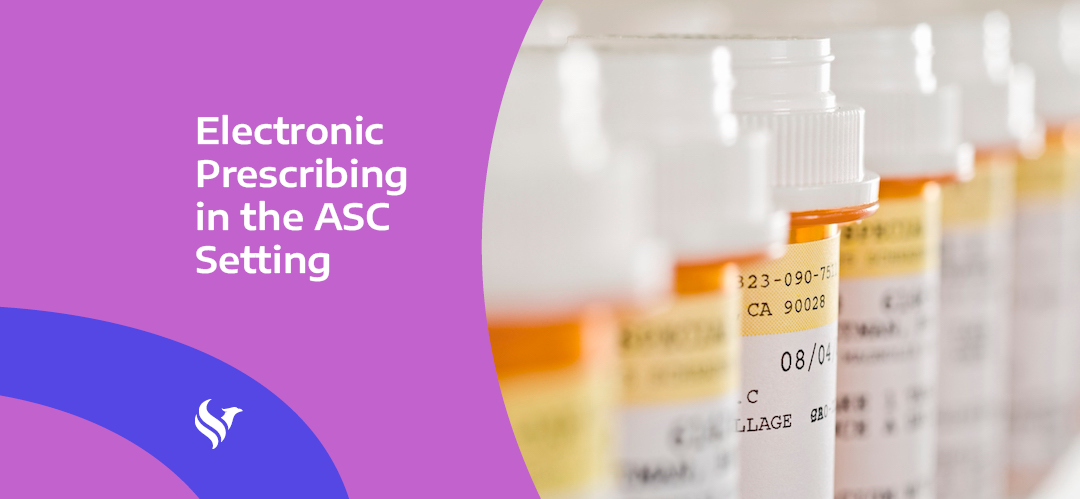Electronic prescribing (ePrescribing) is the electronic transmission of a prescription via the internet. The goal is to allow prescribers to electronically send an accurate, error-free, and understandable prescription directly to a pharmacy from the point of care.
Why is ePrescribing a better option than paper processes?
- Security: It is nearly impossible to forge or illegally obtain prescriptions sent electronically. Missing prescription pads are a thing of the past.
- Control: It is easier to identify patients seeking prescriptions for controlled substances from various care providers.
- Patient Safety: Analytics show there is a decrease in medication errors.
- Increased access to patient medication records: Easily pull up a legible, comprehensive list of all prior medications.
- Improved pharmacy workflow: ePrescribing is quick, efficient, and repeatable.
Legislation to Know
Due to federal and state legislation, ePrescribing is a process all ASCs should be familiar with.
- Federal: The recently released 2022 Physician Fee Schedule Proposed Rule plans to implement phase two of the 2003 SUPPORT Act requirement for the prescribing of controlled substances (pending review of stakeholders comments made before Sept. 13, 2021, regarding extending the start date for compliance to Jan. 1, 2023).
- State: Most states already require all prescriptions or controlled substances to be prescribed electronically.
So how do the Proposed Rule and adjunct State rules affect ASCs? Gina Throneberry, ASCA’s Director of Education and Clinical Affairs, was quoted in Stephen Abresch’s article, “There is still a knowledge deficit about what type of entity has an EHR system.” While EHR technology is in most hospitals and physician offices, many ASCs lack access to the technology needed to comply with state ePrescribing laws. Where the technology is not available, there must be a viable option. Even in those cases where an EHR is available in the ASC, paying for access in the ASC and the office can be pretty prohibitive.
What options are there with and without available technology?
As you read, it’s essential to keep in mind where your team falls and decide what is best for your center. By doing so, you will be better prepared to present the options to prescribers. Let’s explore the options.
Option 1: Submit a waiver. Several proposed exceptions may apply to prescribers where waivers may be applicable.
- The electronic data transmission prescription is unavailable due to a temporary technological or electronic failure of a computer system, application or device, or a service interruption. If prescribing a controlled substance, the prescriber must document the reason for the failed electronic transmission in the patient’s record.
- The prescribing health care practitioner and the dispenser are the same entity.
- For prescribers who issue 100 or fewer controlled substance prescriptions for Part D drugs per calendar year.
- For prescribers experiencing a natural disaster or enduring extraordinary circumstances (such as an influx of patients due to a pandemic).
Option 2: If your ASC does not have an EHR, or if your software does not have an ePrescribe feature, you can purchase standalone prescribing software.
- There are several factors to consider before purchasing prescribing software. The first is whether your team needs to use the software on mobile platforms. The second is whether your team needs enhanced software that provides additional features, such as the ability to check for drug interactions or a patient’s drug allergies.
- Even if the ASC has an EHR, the provider may choose to utilize the ePrescribe feature from the office software via a mobile device or prescribe the post-operative medication from the office during the pre-procedure visit. However, enrolling in, paying for, and learning additional software can be time-consuming and expensive. Two factors to consider:
- Electronic Prescriptions for Controlled Substances (EPCS) clearance costs more due to the regulatory compliance costs
- The software must be certified to comply with a 2010 DEA regulation which requires identity proofing of prescribers and two-factor authentication when signing prescriptions.
Option 3: If your ASC does have an EHR, it should offer the functionality to allow you to sign up for ePrescribing.
- Prescribing directly from the patient’s chart will automatically complete the demographic data for the prescription and has the added benefit of obtaining the patient’s prescription history and storing it in the chart. There is usually a monthly fee for registering and using the ePrescribe feature within the EHR, as this is typically outsourced to a third-party certified prescribing software.
Ultimately, review the options now and decide on a strategy while awaiting the CMS Final Rule. If applicable, reach out to your office EHR vendor or your ASC’s vendor. Even if the federal requirement is delayed, you are most likely in a state that has or will have electronic prescribing mandated by 2022!
Don’t miss out on the good stuff – Subscribe to HST’s Blog & Podcast!
Every month we’ll email you our newest podcast episodes and articles. No fluff – just helpful content delivered right to your inbox.

